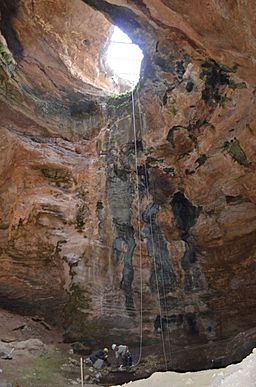Natural Trap Cave facts for kids
Quick facts for kids Natural Trap Cave |
|
|---|---|

View inside the cave
|
|
| Location | Bighorn Mountains |
| Depth | 85 feet (26 m) |
| Elevation | 4,560 feet (1,390 m) |
Natural Trap Cave is a special pit cave located in the Bighorn Mountains in northern Wyoming, United States. It's like a giant, natural pit in the ground. This cave is super important for scientists because it holds many fossils. These fossils come from animals that fell into the cave a very long time ago, during the Late Pleistocene period. Studying these fossils helps us learn about ancient life in North America.
Contents
Exploring Natural Trap Cave
This amazing cave is found northeast of Lovell, Wyoming. It sits high up, at about 4,560 feet (1,390 meters) above sea level. The cave is shaped like a bell, wider at the bottom than at the top. It's about 85 feet (26 meters) deep. The opening at the top is about 12 by 15 feet (3.7 by 4.6 meters) wide. But once you get to the bottom, the cave opens up to about 120 feet (37 meters) across!
First Discoveries in the Cave
The first time scientists really looked into the animal remains in Natural Trap Cave was in 1970. Lawrence Loendorf from the University of Missouri started collecting fossils. He began a bigger digging project in 1971.
Besides animal bones, some interesting human artifacts were found. A Native American red jasper knife was discovered near the entrance. Also, a wooden object, possibly part of an atlatl (a tool for throwing spears), was found in a rat's nest.
In 1972, Carol Jo Rushin from the University of Montana continued the work. Her team dug a 10 by 10-foot (3 by 3-meter) pit. They found bones from 20 different types of mammals and five bird species. These included bones from a dire wolf, an ancient horse, and even a mammoth. Ms. Rushin's research helped explain the cave's history and its importance for understanding ancient life. More digging happened throughout the 1970s.
The bones of animals that have fallen into this pit since the last ice age are piled up over 10 meters (33 feet) deep at the bottom!
Animals Found in the Cave
Many different kinds of animals have been found trapped in Natural Trap Cave.
- Small mammals include pikas, jackrabbits, cottontail rabbits, marmots, chipmunks, Peromyscus mice, woodrats, Microtus voles, and collared lemmings.
- Larger mammals found here are Canis species (like ancient dogs or wolves), red foxes, short-faced bears, weasels, martens, wolverines, American cheetahs, American lions, Equus species (ancient horses), Camelops (ancient camels), deer, antilocaprids (like pronghorns), bison, bighorn sheep, and mammoths.
- It's especially interesting that many remains of the American cheetah have been found in this cave.
Recent Discoveries (2014-2016)
For almost 30 years, the entrance to Natural Trap Cave was covered with a safety grill by the Bureau of Land Management. This helped protect the cave and its contents.
In July and August of 2014, a new team of scientists began exploring the cave again. This team was from Des Moines University and was led by Julie Meachen. She is a paleontologist who studies Pleistocene megafauna (very large ancient animals). This was the first of three yearly digs planned from 2014 to 2016.
What the 2014 Team Found
During their two-week dig, the team found over 200 large bones from big animals. These included American cheetahs, bison, horses, and gray wolfs. They also found countless tiny microfossils from birds and reptiles.
The cave is very cool, staying below 10°C (50°F), and it's very humid (98% humidity). These conditions are perfect for keeping ancient genetic material safe. The team collected samples to be studied for mitochondrial DNA at the Australian Centre for Ancient DNA at the University of Adelaide.
Scientists hope to learn more about why so many large animals became extinct around 10,000 to 17,000 years ago. This time period is known as the Quaternary extinction event. They want to understand if climate change or the arrival of early humans played a role. They also hope to learn about the diet, environment, and genetic variety of these amazing ancient animals.
Packy Le Pew: A Taphonomy Experiment
During the 2014 dig, a pack rat accidentally fell into the pit and died. The team affectionately named it "Packy Le Pew." Instead of removing it, they decided to leave its body undisturbed. This allows them to study how a body decays naturally in the cave's environment. This type of study is called taphonomy, and it helps scientists understand how fossils form over time.
Videos About Natural Trap Cave
- BBC World News Video from August 8, 2014: "Dig this ANCIENT BONES FOUND in Wyoming CAVE BREAKING NEWS 2014"
- Australian Centre for Ancient DNA Video from August 5, 2014: "Insights from Natural Trap Cave" featuring Professor Alan Cooper discussing the fossil finds.
- Newsy Science Video from August 9, 2014: "Remains Of Ancient Horses, Lions, Found In Wyo. Cave"

